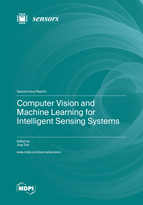Computer Vision and Machine Learning for Intelligent Sensing Systems
A special issue of Sensors (ISSN 1424-8220). This special issue belongs to the section "Intelligent Sensors".
Deadline for manuscript submissions: closed (15 June 2022) | Viewed by 32984
Special Issue Editor
Interests: computer vision; machine learning; video analytics; multimedia application
Special Issues, Collections and Topics in MDPI journals
Special Issue Information
Dear Colleagues,
With the rapid development of computer vision and machine learning technology, intelligent sensing systems have been fueled to make sense of vision sensory data to address complex and challenging real-world sense-making problems. This has raised tremendous opportunities and challenges of managing and understanding vision sensory data for intelligent sensing systems. With the recent advances in machine learning techniques, we are now able to better analyze vision sensory data. This has attracted massive research efforts devoted to addressing challenges in this area, including visual surveillance, smart cities, healthcare, etc. The Special Issue aims to provide a collection of high-quality research articles that address the broad challenges in both theoretical and application aspects of computer vision and machine learning for intelligent sensing systems.
The topics of interest include but are not limited to:
- Computer vision for intelligent sensing systems:
- Sensing, representation, modeling;
- Restoration, enhancement, and super-resolution;
- Color, multispectral, and hyperspectral imaging;
- Stereoscopic, multiview, and 3D processing;
- Machine learning for intelligent sensing systems:
- Classification, detection, segmentation;
- Action and event recognition, behavior understanding;
- Multimodal machine learning;
- Computer vision applications for healthcare, manufacture, security and safety, biomedical sciences, and other emerging applications.
Dr. Jing Tian
Guest Editor
Manuscript Submission Information
Manuscripts should be submitted online at www.mdpi.com by registering and logging in to this website. Once you are registered, click here to go to the submission form. Manuscripts can be submitted until the deadline. All submissions that pass pre-check are peer-reviewed. Accepted papers will be published continuously in the journal (as soon as accepted) and will be listed together on the special issue website. Research articles, review articles as well as short communications are invited. For planned papers, a title and short abstract (about 100 words) can be sent to the Editorial Office for announcement on this website.
Submitted manuscripts should not have been published previously, nor be under consideration for publication elsewhere (except conference proceedings papers). All manuscripts are thoroughly refereed through a single-blind peer-review process. A guide for authors and other relevant information for submission of manuscripts is available on the Instructions for Authors page. Sensors is an international peer-reviewed open access semimonthly journal published by MDPI.
Please visit the Instructions for Authors page before submitting a manuscript. The Article Processing Charge (APC) for publication in this open access journal is 2600 CHF (Swiss Francs). Submitted papers should be well formatted and use good English. Authors may use MDPI's English editing service prior to publication or during author revisions.
Keywords
- Machine learning
- Deep learning
- Computer vision
- Image classification
- Image analysis
- Object detection
- Image segmentation
- Action recognition







